雲のいろいろ (十種雲形)
 |
ご隠居生活の暇つぶしに、3か月前から水彩画を趣味で始めてみました。 お見苦しい絵ですが、その練習として雲の姿を描いてみました。御笑覧くだされ。 retired lazy tommy |
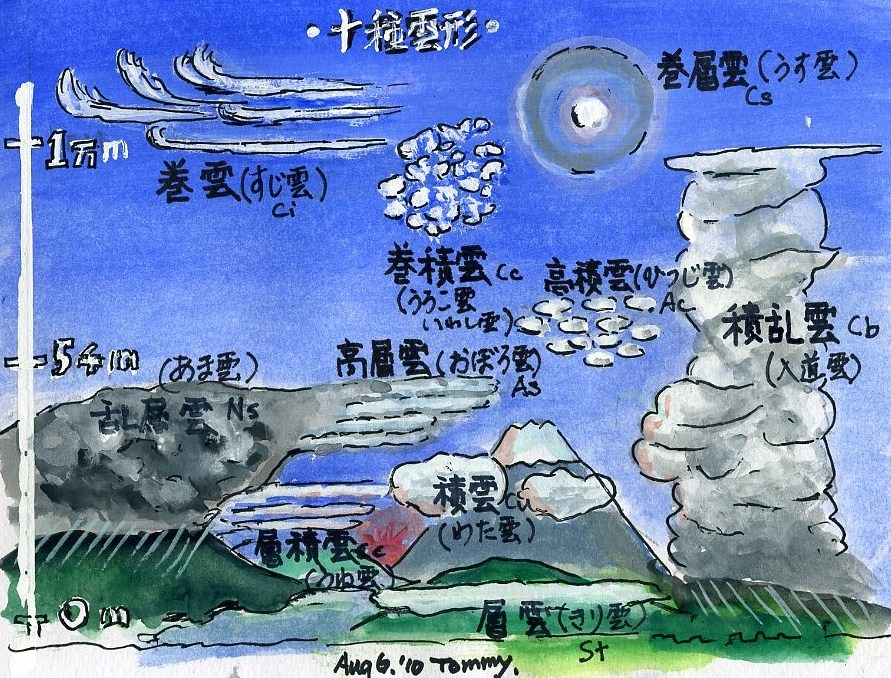 |
★この図は、10種の雲形の大まかな形と、空の高さを示しています。 ★下の図は、其々の雲の形です。(オンラインにある数ある写真の中から特徴がよく出ていて、美しいものを厳選して、資料として使用させていただきました) |
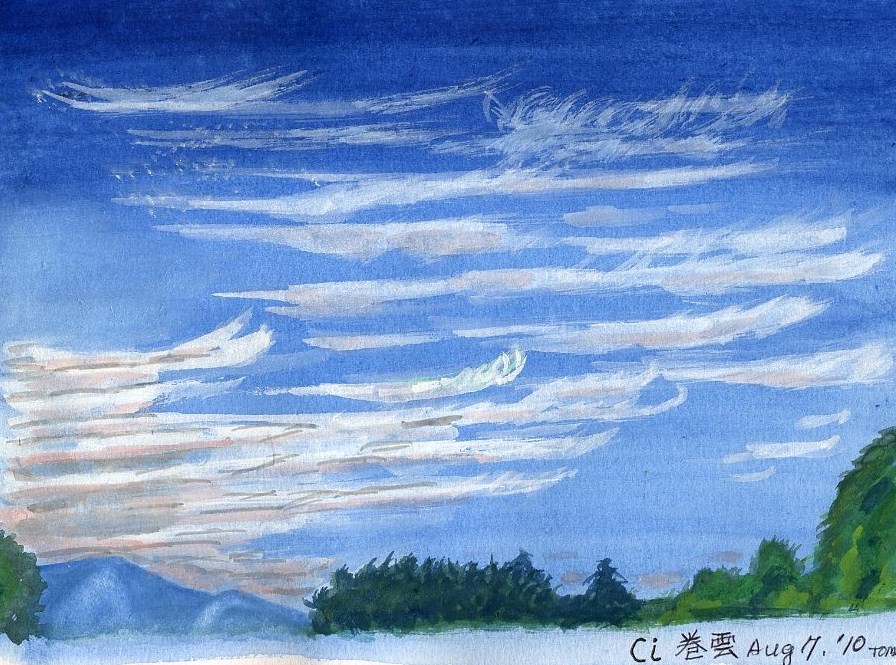 |
No.1 巻雲(けんうん) 記号 Ci 正式名 Cirrus ★すじ雲ともいいます。春秋に現れ風の強い日にすじ状や巻き毛のような、あるいはポニーテールのような綺麗な白い雲を作ります。 ★温暖前線を昇りゆくときにも現れるので天気が崩れる予兆になることもあります。 ★一万メートル前後の高い空に出来る氷の粒でできている雲で、時には飛行機雲からも発生します。 |
 |
No.2 巻積雲(けんせきうん) Cc Cirrocumulus ★一万メートル近くの高い空に、風になびいて作られる「うろこ」のような雲で、「うろこ雲」とか「いわし雲」とか呼ばれます。 ★後で出てくる高層雲(ひつじ雲)や高層雲(おぼろ雲)に似ていますが、雲片が小指の幅より小さければ巻層雲と考えられます。下の図はちょっと雲片が大きすぎますね。ひつじ雲と違い完全に氷の粒で出来ています。 |
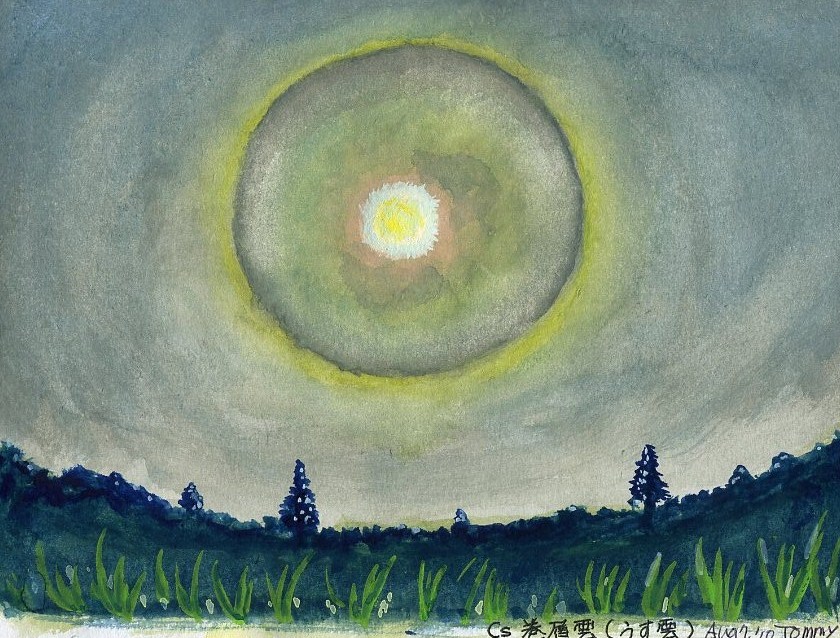 |
No.3 巻層雲(けんそううん) Cs Cirrosstratus ★通称、「うす雲」といいますが、おぼろ雲ではありません。下の図は、太陽が丸い暈(かさ)を作っている姿です。空いっぱいに薄い雲がベールのように覆います。 ★しかし、太陽が暈を作っていても地上が曇りの日になることなく、晴れていて、地上には影ができます。暈は氷の粒の為出来、時には虹色のスペクトルを出すなど光の現象が現れます。 ★もっと下部にできる高層雲(おぼろ雲)と間違われますが、太陽光はしっかりと通過しています。 |
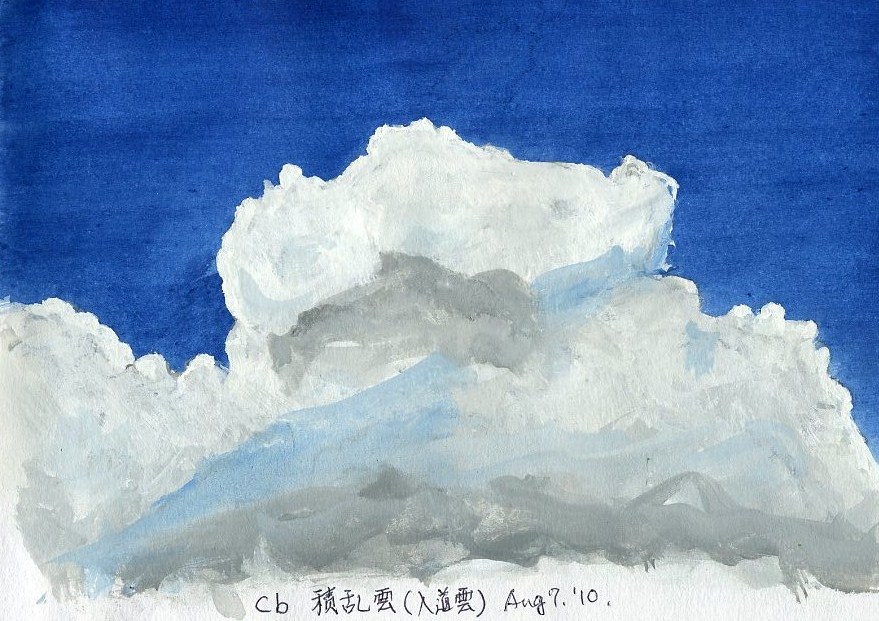 |
No.4 積乱雲(せきらんうん) Cb Cumulonimbus ★通称、「入道雲」。積雲が巨大になったもので、中には一万メートルまで達するものもあり、そうなると雲は形成できないので飛散霧消して、結局、頂上部分はまっ平らになったりします。 ★左の図は、積雲がかなり巨大化したもので、「雄大積雲」とか「入道雲」ともいいます。 |
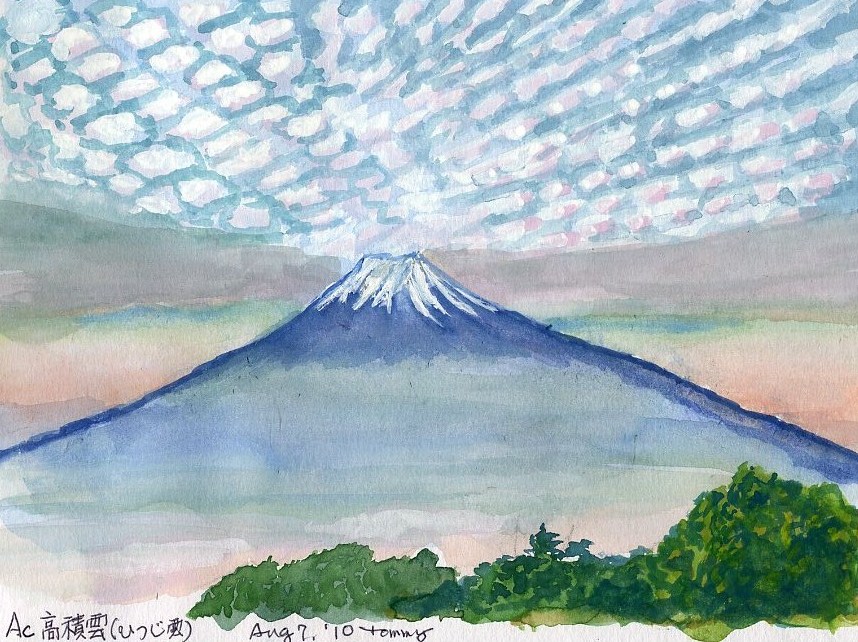 |
No. 5 高積雲(こうせきうん) Ac Altocumulus ★通称「ひつじ雲」とも呼ばれ、うろこ雲の卷積雲に形が似ているが、高度は五千メートル以下のところであり、氷の粒と共に、水の粒も混在する雲です。 ★卷積雲と比べると、雲片がかなり大きいのが特徴です。風によっては、レンズのような形をした「レンズ雲」になりこともあります。 |
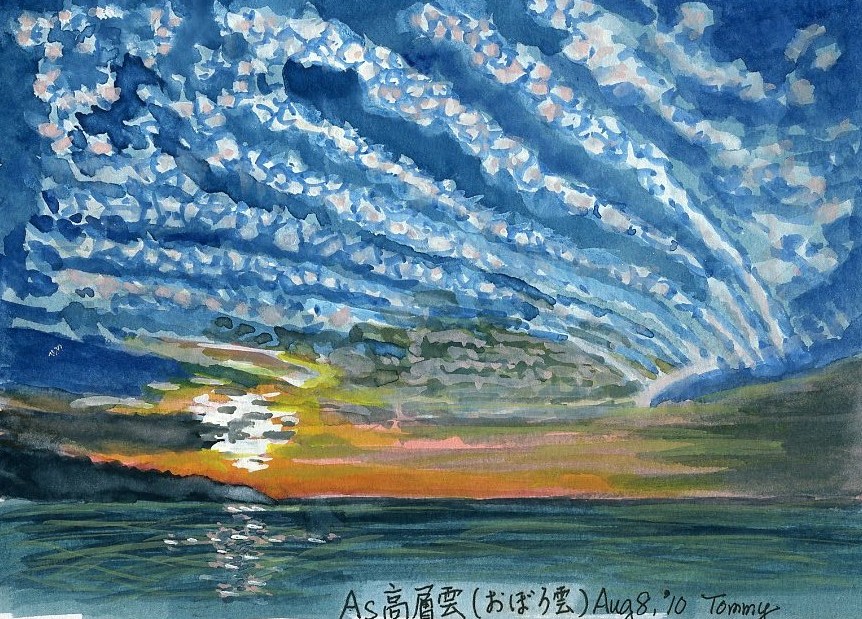 |
No.6 高層雲(こうそううん) As Altostratus ★薄く広がる雲で、通称「おぼろ雲」といいます。おぼろ弁当を思い出して、美味しそうですね。 ★卷積雲に似ていますが、水滴のため暈(かさ)は出来ません。太陽光はなんとか通すが、ぼんやりです。 |
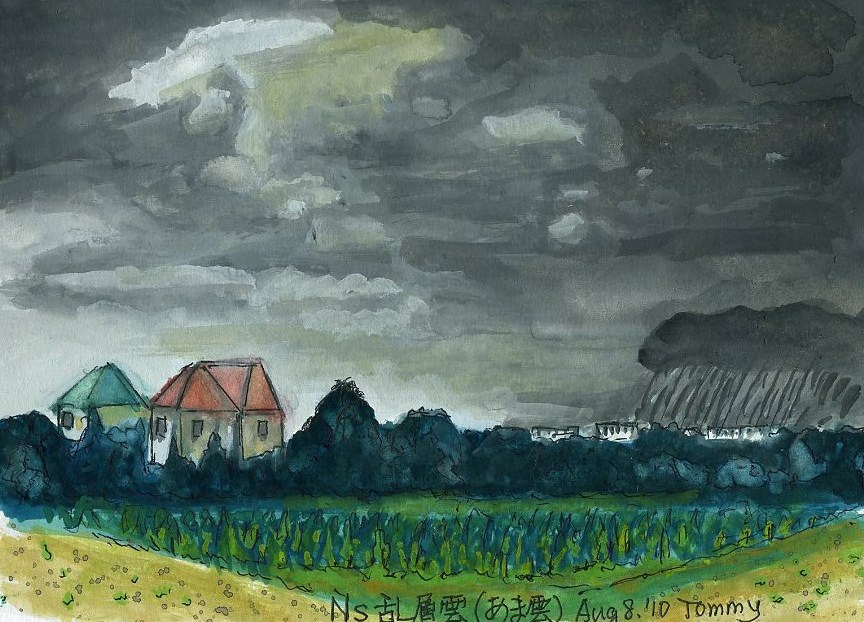 |
No.7 乱層雲(らんそううん) Ns Nimbostratus ★通称「あま雲」で、雨を降らせます。 ★模様も多様で、空一面に灰色や黒い雲で覆い、心を不安にします。恵みの雨でもありますが、、、。 |
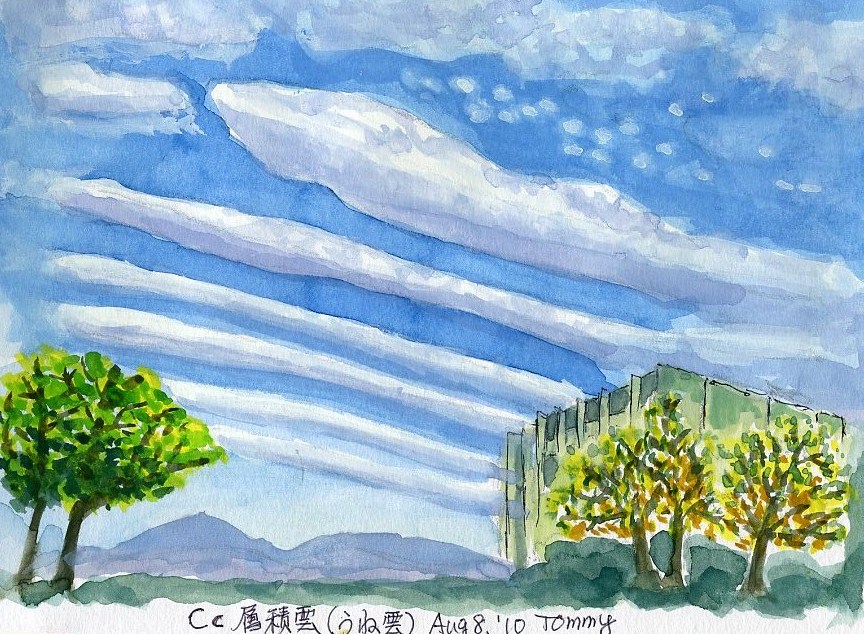 |
No.8 層積雲(そうせきうん) Sc Stratocumulus ★通称、「うね雲」と呼ばれ、よく見かける雲です。、様々な形の雲が低い空に広がっています。層状であったり、丸みがついていたりします。 ★雲間から美しい青空が見えたり、太陽が顔を覗かせると、光がすじ状にこもれたりして、ロマンチックな気分になります。 ★色も白から黒までありますが、、夏目漱石が愛していたという話は特にありません。 |
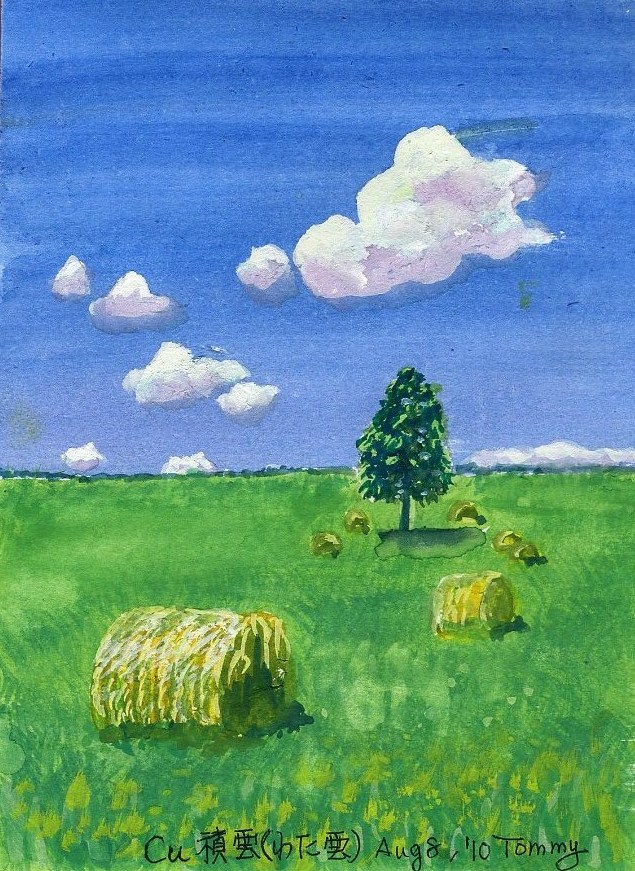 |
No.9 積雲(せきうん) Cu Cumulus ★雲の中の雲、御存じ「わた雲」です。ぽっかり浮かんだ白い雲で、色々な形に見えるので、想像力に事欠きません。私などはよく女体を意識したりして、困ってしまいます。 ★暑い夏には、わた雲がさらに発達すると雄大積雲(入道雲)になり、積乱雲になります。カミナリさんが活躍したりします。 |
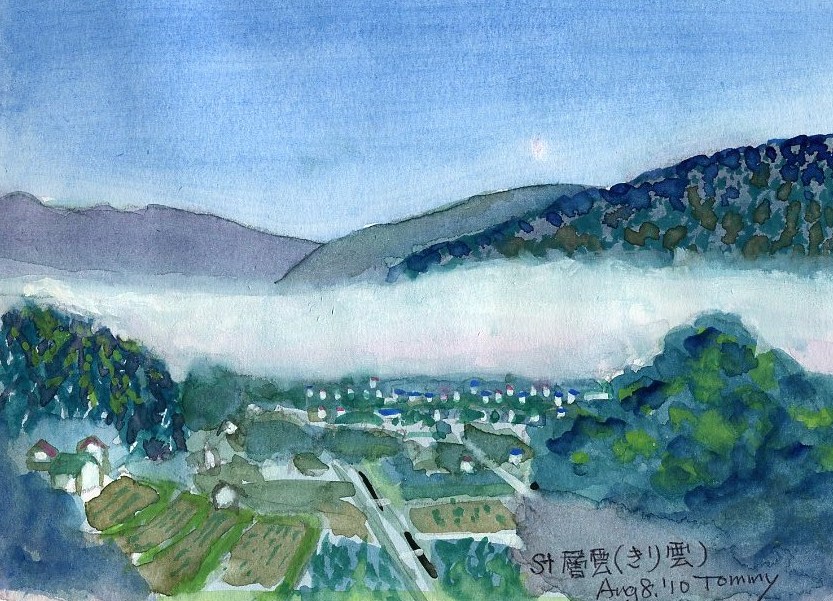 |
No.10 層雲(そううん) St Stratus ★通称、「きり雲」と呼ばれ、地上近くに現れる霧状の雲です。もちろん、地上にまで降りてくれば、霧そのものです。 ★水滴で出来ており、早朝や山でよく見られます。シドニーやオークランドの高層ビルの下にこの雲が這うと、まるで天空の城「ラピュタ」のような光景となります(下記)。 |
 |
層雲がかかり、天空の城「ラピュタ」を思い出させる ニュージーランドの都市オークランドの風景 (2008年5月撮影) |
Formation and Classification of Clouds --- from WIKIPEDIA
Clouds are formed when water evaporates from oceans, lakes, and ponds or by evapotranspiration over Earth's land surface and rises up into colder areas of the atmosphere due to convective, oragraphic, or frontal lifting. The water vapor attaches itself to condensation nuclei which could be anything from dust to microscopic particles of salt and debris. Once the vapour has been cooled to saturation, the cloud becomes visible.
Clouds can be divided into three main categories based upon the Latin root words which refer to the process of formation and physical structure of the clouds. The first of the three is Cirrus, which has only one genus and therefore shares the same name. It is in the high altitude range and occurs mostly in the form of filaments. The other two are Stratus that are mostly sheet-like in structure, and Cumulus that appear heaped, rolled, and/or rippled. Stratus and Cumulus occur in the high, medium, and low levels of the troposphere, so each of these categories have several cloud genera.
[1]
A total of ten cloud genera are derived by cross-classification of the stratus and cumulus categories into high (prefix cirro-), medium (prefix alto)-, low (no height related prefix), and low to medium (which has its own height criteria) ranges for a subtotal of eight main types. To these are added cirrus which is always high, and cumulonimbus which has its own height range characteristics as a cloud of vertical development.
[2]
Some classifications include the genus cumulus as a cloud of vertical development, but only its largest species, cumulus congestus, can be properly considered for this designation. Prefixes for cloud genera belonging to height ranges other than high and medium are either absent or refer to characteristics other than the height range.
The essentials of the modern nomenclature system for clouds were proposed
by Luke Howard, a British manufacturing chemist and an amateur meteorologist
with broad interests in science, in an 1802 presentation to the Askesian
Society. Since 1890, clouds are classified and illustrated in cloud atlases.